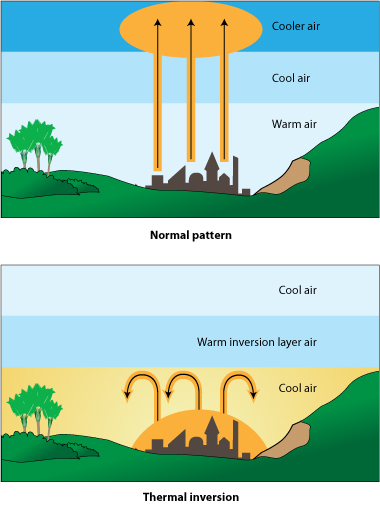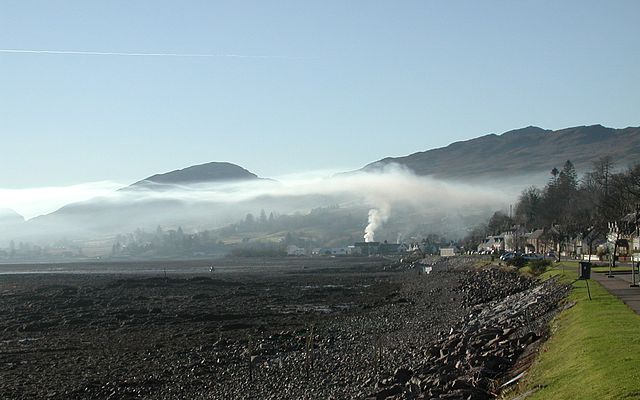As the cold grips the city of Karachi and the rest of the country, everyone is concerned with the smog, but fewer are aware that an important phenomenon and one of the main reasons for smog is known as the “Temperature Inversion Layer”.
The inversions are stable air masses where the warm air overlays the excellent air mass. The more generous top layer creates a blanket over the more excellent air mass below, which seizes the vertical movement of the atmosphere by trapping the cool air mass underneath it, along with all the pollutants suspended in it.
This is precisely the opposite of the typical temperature profile. Hence the name “temperature inversion”. Earth’s atmosphere is divided into layers i.e., troposphere, stratosphere, mesosphere, exosphere, etc. These layers are divided based on their physical parameters, such as temperature and density. In each layer, these parameters change. Usually, the air temperature decreases with increasing height in the troposphere.
In the case of inversion, the temperature gradient behavior inverts i.e., the lower layers of air become cooler than the upper layers.

How is it formed?
One of the reasons for temperature inversion to form is when a warm, less dense air mass moves over the cooler and denser air mass. This traps the cool air below the warm air, creating an inversion layer.
Under normal conditions, the lower layers of the air in the troposphere are heated by the radiation emitting from the Earth. The heat then travels upwards via convection and increases the temperature of the upper layers of air in the troposphere. Temperature inversion can also form if the Earth cools rapidly via radiation. This usually occurs during the winter or at night. The air near the Earth’s surface cools along with it. The air above the surface layer does not cool as rapidly as the air near the surface, creating an inversion layer.
Conditions
There are a few conditions for this phenomenon to occur:
- The first is the temperature. The winter season provides the necessary requirements to trigger an inversion event.
- Similarly, the time of the day is another factor. The inversion layer occurs during sunrise when the ground has cooled off and starts cooling the air layer near the surface.
- Strong winds help in the mixing of air masses. During calm weather, the air masses stay stable and do not mix. This increases the chances of an inversion layer occurring.
- Similar to the wind effect, precipitation also helps in the mixing and moving of air masses. Lack of rainfall allows stable air masses to exist, contributing to the inversion layer events.
- Additionally, the topography plays an important role in this. Cool air sinks at the bottom of the valleys and depressions, increasing the possibility of an inversion layer.

Types of Inversions
There are four kinds of inversions: ground, turbulence, subsidence, and frontal.
Ground Inversion: The air near the surface cools rapidly due to the cooling of the Earth’s surface. The upper layers remain warmer than the bottom layer. Additionally, if the temperature of the bottom layer reaches the dew point, fog will form.
Moreover, in hilly areas, the cool air sinks from the hill slopes toward the bottom, creating an inversion layer.
Turbulence Inversion: This occurs when a turbulent air mass is overlain by static or calm air mass. Turbulent air mass loses heat due to mixing, whereas the static air mass remains warm.
Subsidence Inversion: Due to high pressure, the air descends rapidly from a higher altitude and heats up due to compression. The air at the bottom remains cooler, hence creating an inversion layer.
Frontal Inversion: This type of inversion happens when a warm air mass overlays a cool air mass. The difference in their densities doesn’t allow mixing; therefore, the warm front, being less dense, wedges over the cool front.

The Problem
In normal circumstances, the vertical movement of the air persists, which allows the mixing and dispersion of the air. In the case of temperature inversion, warm air rises, trapping the cool air underneath it. This seizes the vertical motion of the air. This also traps the smoke and pollutants from escaping. These particles don’t move because the airflow is blocked. The particles then combine to become even more lethal, leaving behind persistent, dangerous smog.
In the northern hemisphere, inverse temperatures are more frequent in the winter. Additionally, burning wood or coal in homes for heat increases air pollution by releasing more dangerous contaminants into the atmosphere. Increased pollution combined with the inversion mechanism is the perfect recipe for respiratory diseases among people. Diseases such as sore throat, conjunctivitis, and lung irritation are a few common issues related to being in so much polluted air.
Understanding the Temperature Inversion Layer is crucial in addressing the air quality challenges that arise during winter. Efforts to mitigate pollution should consider these atmospheric intricacies. Whether it’s promoting cleaner energy sources, regulating industrial emissions, or fostering awareness about the impact of individual activities, acknowledging the role of temperature inversion is a vital step toward breathable and healthier urban environments.
As we navigate the winter season, it’s not just about bundling up against the cold; it’s about unraveling the layers of atmospheric complexities that impact our health and well-being. By unveiling the secrets behind temperature inversion, we can make informed decisions that contribute to cleaner air and a safer environment.
References:
- Britannica
- Geography Point
- Essentials of Meteorology – An invitation to the atmosphere by C. Donald Ahrens
- NOAA
- Science Learning Hub
- https://www.drishtiias.com
- Energy Education

Adnan Baig is a space science graduate who also served as a student research assistant at the Leibniz Institute of Astrophysics, Potsdam, Germany. He has co-authored several international research publications. Adnan is interested in space research, astrophysics, environmental science, nature photography, writing, reading and watching movies and anime.

